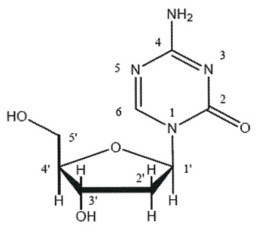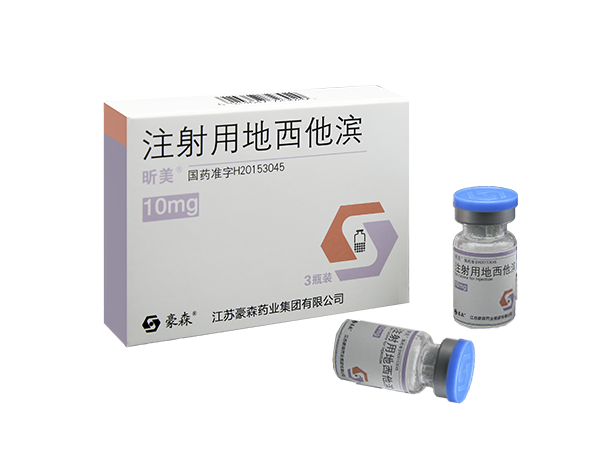| 【Ingredient】 |
The main ingredient of this product is Decitabine.
Chemical Name:4-amino-1-(2-deoxy-β-D-erythro-pentofuranosyl)-1,3,5-triazine-2(1H)-one Chemical Structure: 
Molecular formula: C8H12N4O4 Molecular weight: 228.21 Excipients: potassium dihydrogen phosphate, sodium hydroxide. |
| 【Indications】 |
Decitabine is indicated for treatment of patients with myelodysplastic syndromes (MDS) including previously treated and untreated, de novo and secondary MDS of all French-American-British (FAB classification) subtypes (refractory anemia (RA), refractory anemia with ringed sideroblasts (RARS), refractory anemia with excess blasts (RAEB), refractory anemia with excess blasts in transformation (RAEB-t), and chronic myelomonocytic leukemia (CMML)) and intermediate-1, intermediate-2, and high-risk International Prognostic Scoring System groups |
| 【Dosage and Administration】 |
Complete blood counts and platelet counts should be performed as needed to monitor response and toxicity, but at a minimum, prior to each cycle. Liver chemistries and serum creatinine should be obtained prior to initiation of treatment.
Two treatment regimens are recommended:
Treatment Regimen – Option 1 (3-day treatment regimen)
Decitabine is administered at a dose of 15 mg/m2 by continuous intravenous infusion over 3 hours repeated every 8 hours for 3 days. Patients may be premedicated with standard anti-emetic therapy. Treatment cycle
A cycle should be repeated every 6 weeks. With either regimen it is recommended that patients be treated for a minimum of 4 cycles; however, a complete or partial response may take longer than 4 cycles. If the patient continues to benefit, then medication can continue.
The dose is modified or delayed according to the blood laboratory test value.
If hematologic recovery (ANC ≥ 1,000/μL and platelets ≥ 50,000/μL) from a previous Decitabine treatment cycle requires more than 6 weeks, then the next cycle of Decitabine therapy should be delayed and dosing temporarily reduced by following this algorithm:
●Recovery requiring more than 6, but less than 8 weeks – Decitabine dosing to be delayed for up to 2 weeks and the dose temporarily reduced to 11 mg/m2 every 8 hours (33 mg/m2/day, 99 mg/m2/cycle) upon restarting therapy.
●Recovery requiring more than 8, but less than 10 weeks − Patient should be assessed for disease progression (by bone marrow aspirates); in the absence of progression, the Decitabine dose should be delayed up to 2 more weeks and the dose reduced to 11 mg/m2 every 8 hours (33 mg/m2/day, 99 mg/m2/cycle) upon restarting therapy, then maintained or increased in subsequent cycles as clinically indicated.
Dose modification or delayed administration based on non-hematologic toxicity
●After the first decitabine treatment cycle, if the following non-hematologic toxicity occurs, discontinue decitabine until the toxicity disappears: 1) serum creatinine ≥ 2 mg / dL; 2) alanine aminotransferase (ALT) ), total bilirubin ≥ 2 times the upper limit of normal value (ULN); 3) active or uncontrolled infection.
Treatment Regimen – Option 2 (5-day treatment regimen)
Decitabine is administered at a dose of 20 mg/m2 by continuous intravenous infusion over 1 hour repeated daily for 5 days. This cycle should be repeated every 4 weeks. Patients may be premedicated with standard anti-emetic therapy. If myelosuppression is present, subsequent treatment cycles of Decitabine should be delayed until there is hematologic recovery (ANC ≥ 1,000/μL platelets ≥ 50,000/μL). Following the Treatment Regimen – Option 2 if any of the non-hematologic toxicities are present.
Based on foreign clinical research data, the 5-day treatment regimen is better tolerated than the 3-day treatment regimen. The regimen has been approved abroad. Chinese people have limited application experience. Ask the attending doctor to choose a reasonable treatment regimen based on the condition of the Chinese patient. Intravenous administration
Decitabine is a cytotoxic drug and caution should be exercised when handling and preparing Decitabine. Procedures for proper handling and disposal of antineoplastic drugs should be applied.
Decitabine should be aseptically reconstituted with 10 mL of Sterile Water for Injection; upon reconstitution, each mL contains approximately 5.0 mg of decitabine at pH 6.7-7.3. Immediately after reconstitution, the solution should be further diluted with 0.9% Sodium Chloride Injection or 5% Dextrose Injection to a final drug concentration of 0.1 -1.0 mg/mL. Unless used within 15 minutes of reconstitution, the diluted solution must be prepared using cold (2˚C -8˚C) infusion fluids and stored at 2˚C -8˚C (36˚F -46˚F) for up to a maximum of 7 hours until administration.
Parenteral drug products should be inspected visually for particulate matter and discoloration prior to administration, whenever solution and container permit. Do not use if there is evidence of particulate matter or discoloration.
|
